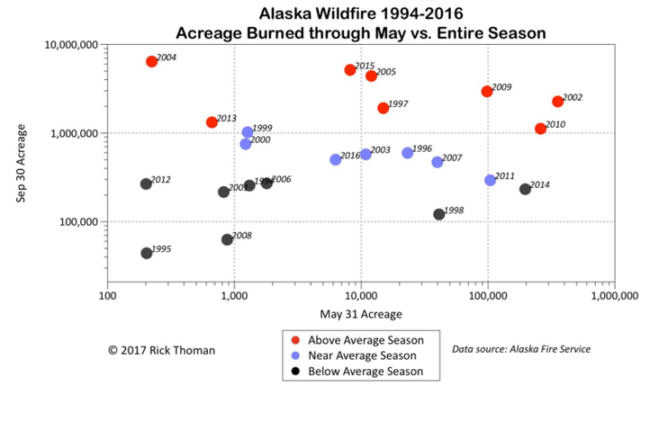
Wildfire season is off to a slow start in Alaska. But that could change very quickly. That’s because predicting how severe a wildfire season will be in the state is so tricky.
Alaska’s Energy Desk is checking in with climatologist Brian Brettschneider each week as part of the segment, Ask a Climatologist.
Brettschneider says over the entire season, which runs through the end of July, no wildfire forecast is useful for Alaska.
Interview Transcript:
Brian: Conditions that promote fire are highly dependent on just a few days of meteorological conditions. So if temperatures are warm, that gives you low relative humidity. If there’s a breeze that literally can fan fires and then you need an ignition source, which can be human ignition or most commonly, lightning. Those are things that more than a few days out are really hard to forecast, which is different in the lower 48 where long term drought, the curing of grasses- those kinds of things you can see and you can forecast weeks and even months in advance. You can track them over long periods of time.
Here in Alaska, we don’t really have drought conditions, per se. So it really is the meteorological conditions over a relatively short period of time that drive the propensity for fires to start and spread.
Annie: So things can kind of switch in an instant?
Brian: They really can. You can have wet after wet, cloudy, cool and then just a week of warm and dry, and throw in some lightning strikes and the whole state could erupt, figuratively speaking.
Annie: And lightning is the key for most fires in Alaska?
Brian: It is. If you look at the stats in terms of acreage burned, it’s by far lightning caused. It pretty reliably kicks in the first half of June. And once it does, that’s when we’re going to see the fire acreage expand. So far the lightning season hasn’t really kicked in yet, but it will, it always does. And then the question is how many of those will ignite new fires.
Once we head into June in the high sun season, in interior Alaska you get near continuous daylight, you get solar heating for most of the day. So you end up with lower pressure, warm temperatures and that promotes what’s called a thermal trough, and that helps facilitate storm development and lightning strikes.
Annie Feidt is the broadcast managing editor at Alaska Public Media. Reach her at afeidt@alaskapublic.org. Read more about Annie here.





